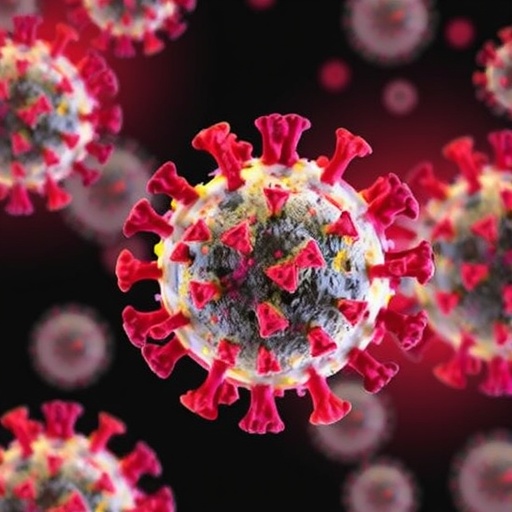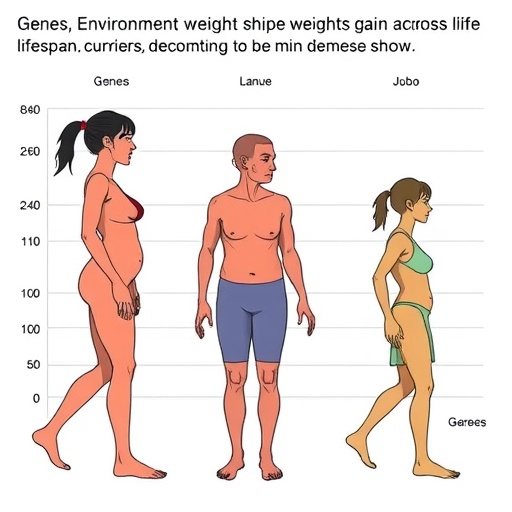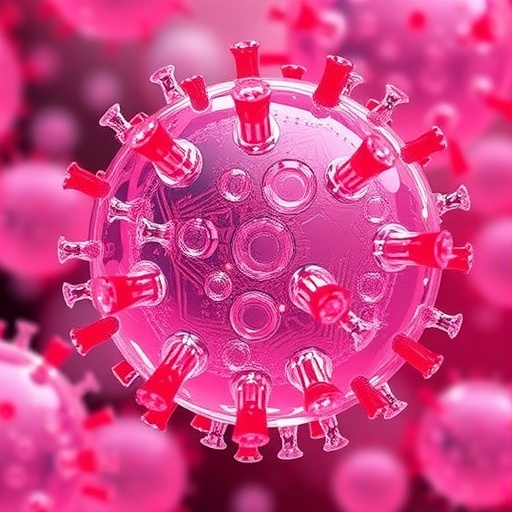In a groundbreaking study poised to redefine our understanding of coronavirus replication, scientists have pinpointed the critical role of the c-Jun N-terminal kinase (JNK) in modulating the phosphorylation of the nucleocapsid (N) protein of the human coronavirus HCoV-229E. This discovery opens new avenues for antiviral therapies, specifically targeting host cellular mechanisms to reduce viral propagation effectively. Employing advanced live-cell microscopy and biochemical techniques, the research team has illuminated how the virus hijacks cellular signaling pathways to ensure its survival and replication within host cells.
The nucleus of this research centered on the JNK pathway, a mitogen-activated protein kinase involved in cellular stress responses, apoptosis, and inflammation. By deploying a kinase translocation reporter (KTR), investigators could dynamically monitor JNK activity in living cells infected with HCoV-229E. Remarkably, a pronounced surge in JNK activity was observed approximately 16 hours post-infection, revealing the kinase’s temporal regulation during coronavirus replication. This activation was confined to infected cells, underlining its specificity and implicating JNK as a pivotal host factor manipulated by the virus.
Pivotal to understanding the virus-host interplay, the team demonstrated that inhibition of JNK kinase resulted in a marked reduction in viral progeny. Targeted chemical inhibitors of JNK hindered the replication efficiency of not only HCoV-229E but also SARS-CoV-2, confirming the kinase’s conserved role across multiple coronavirus strains. This finding suggests that viral replication is heavily dependent on the phosphorylation state of viral components modulated by JNK, establishing the kinase as a potential universal therapeutic target.
Further mechanistic insights emerged through collaboration with Professor Michael Kracht’s group at the University of Giessen. Their investigations revealed that JNK directly phosphorylates serine residues on the N protein of HCoV-229E. Significantly, these phosphorylation sites are conserved across diverse coronaviruses, hinting at an evolutionarily preserved mechanism by which coronaviruses control the function of their nucleocapsid proteins. Such post-translational modifications likely facilitate crucial steps in viral RNA packaging, assembly, and genome stabilization, underscoring the importance of kinase-mediated regulation.
The nucleocapsid protein, a multifunctional viral component, plays an indispensable role during replication by organizing the viral RNA into a ribonucleoprotein complex. Phosphorylation by host kinases like JNK may influence the N protein’s structural conformation or interaction affinity with viral RNA and other viral or host proteins. This fine-tuned modulation is vital for efficient virion assembly and subsequent viral maturation. Disrupting this phosphorylation could consequently impair viral assembly, curtailing the production of infectious particles.
Through quantitative immunofluorescence assays, the research team quantified JNK activation levels and correlated them with viral replication metrics. These experiments conclusively demonstrated that blocking JNK’s activity translates directly to decreased virus titers. Moreover, live-cell imaging captured dynamic shifts in JNK localization and activity, substantiating the kinase’s involvement specifically during active infection phases rather than being a generalized stress response.
This study’s implications extend beyond understanding viral biology; it lays a conceptual foundation for therapeutic development. Current antiviral strategies predominantly target viral proteins, often leading to resistance due to rapid viral mutation. By contrast, targeting host factors like JNK kinases may impose a higher barrier to resistance development since the virus relies on stable host cell processes. The conserved nature of JNK’s role across coronaviruses fortifies its candidacy as a broad-spectrum antiviral target.
A particularly intriguing aspect is the temporal specificity of JNK activation around 16 hours post-infection, a window that may reflect critical replication or assembly events within the viral life cycle. This time-dependent activation provides an opportunity for precision intervention, where therapeutic agents could be administered to intercept viral replication at its most vulnerable phase. Comprehensive understanding of this temporal regulation might yield optimized treatment regimens that maximize efficacy while minimizing cellular toxicity.
The researchers meticulously employed kinase inhibitors with high specificity for JNK to ensure observed effects were directly attributable to JNK activity modulation. This precision underscores the robustness of their conclusions and minimizes off-target confounding factors commonly encountered in kinase research. Their integrated approach combining visual imaging, biochemical validation, and virological assays exemplifies a rigorous standard for defining host-pathogen interactions.
The discovery also prompts re-examination of JNK’s role in other RNA viruses, given that kinases often serve as central nodes for viral exploitation of host signaling. Future investigations might explore whether analogous phosphorylation-dependent mechanisms govern the replication of diverse viral families. Such studies could reveal universal principles of virus-host interactions and propel the development of kinase-targeted therapeutics with broader antiviral applications.
Beyond direct antiviral implications, understanding how coronaviruses commandeer JNK signaling contributes to our comprehension of virus-induced cellular pathogenesis. JNK is intricately linked to inflammatory responses, and its activation may influence the host immune landscape during infection. Therapeutic modulation of JNK could potentially temper deleterious inflammation as well as viral replication, offering dual benefits in clinical management of coronavirus infections.
The advancements reported in this study derive from state-of-the-art molecular biology tools, reflecting the power of interdisciplinary collaboration. The convergence of virology, cell biology, and chemical biology enabled researchers to dissect the nuanced mechanisms of kinase regulation by viral proteins. Such integrative strategies underscore the trajectory of modern biomedical research toward holistic understanding and innovative treatment design.
In conclusion, this pivotal research underscores the indispensability of JNK kinase in the coronavirus life cycle, particularly regarding the phosphorylation of the nucleocapsid protein critical for viral replication. The findings not only illuminate viral exploitation of host kinase pathways but also spotlight promising targets for next-generation antiviral agents. As the global community continues to confront coronavirus-related health challenges, these insights furnish hope for innovative therapeutic interventions that harness vulnerabilities within viral replication machinery.
Subject of Research: Cells
Article Title: JNK kinase regulates phosphorylation of HCoV-229E nucleocapsid protein
News Publication Date: 18-Sep-2025
Web References: 10.1038/s44298-025-00152-7
Image Credits: © Molekulare und medizinische Virologie
Keywords: JNK kinase, coronavirus, HCoV-229E, SARS-CoV-2, nucleocapsid protein, phosphorylation, viral replication, kinase translocation reporter, antiviral targets, host-virus interaction.
Tags: antiviral therapies targeting host factorsc-Jun N-terminal kinase role in viral infectioncoronavirus replication mechanismscoronavirus-host interaction studieshost cellular signaling pathwaysJNK activity in HCoV-229E infectionJNK pathway in cellular stress responseskinase translocation reporter technologylive-cell microscopy in virus researchphosphorylation of nucleocapsid proteinreducing viral propagation strategiesviral progeny inhibition techniques





